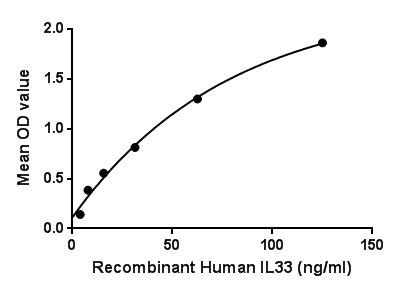Active Interleukin 33 (IL33) 

DV27; C9ORF26; IL1F11; NFHEV; Interleukin-1 Family, Member 11; Nuclear factor from high endothelial venules
- UOM
- FOB US$ 328.00 US$ 820.00 US$ 1,640.00 US$ 4,920.00 US$ 12,300.00
- Quantity
Overview
Properties
- Product No.APB980Hu01
- Organism SpeciesHomo sapiens (Human) Same name, Different species.
- ApplicationsCell culture; Activity Assays.
Research use only - DownloadInstruction Manual
- CategoryCytokineInfection immunity
- Buffer FormulationPBS, pH7.4, containing 0.01% SKL, 5% Trehalose.
- Traits Freeze-dried powder, Purity > 95%
- Isoelectric Point5.5
Sign into your account
Share a new citation as an author
Upload your experimental result
Review

Contact us
Please fill in the blank.
Activity test

Figure. The binding activity of IL33 with IL1RL1.
Interleukin 33 is a member of the IL-1 family that potently drives production of T helper-2 (Th2)-associated cytokines. IL33 is a ligand for ST2 (IL1RL1), an IL-1 family receptor that is highly expressed on Th2 cells, mast cells and group 2 innate lymphocytes. IL-33 is expressed by a wide variety of cell types, including fibroblasts, mast cells, dendritic cells, macrophages, osteoblasts, endothelial cells, and epithelial cells. Besides, Interleukin 1 Receptor Like Protein 1 (IL1RL1) has been identified as an interactor of IL33, thus a binding ELISA assay was conducted to detect the interaction of recombinant human IL33 and recombinant human IL1RL1. Briefly, IL33 were diluted serially in PBS, with 0.01% BSA (pH 7.4). Duplicate samples of 100uL were then transferred to IL1RL1-coated microtiter wells and incubated for 2h at 37℃. Wells were washed with PBST and incubated for 1h with anti-IL33pAb, then aspirated and washed 3 times. After incubation with HRP labelled secondary antibody, wells were aspirated and washed 3 times. With the addition of substrate solution, wells were incubated 15-25 minutes at 37℃. Finally, add 50µL stop solution to the wells and read at 450nm immediately. The binding activity of IL33and IL1RL1 was shown in Figure 1, and this effect was in a dose dependent manner.
Usage
Reconstitute in 10mM PBS (pH7.4) to a concentration of 0.1-1.0 mg/mL. Do not vortex.
Storage
Avoid repeated freeze/thaw cycles. Store at 2-8°C for one month. Aliquot and store at -80°C for 12 months.
Stability
The thermal stability is described by the loss rate. The loss rate was determined by accelerated thermal degradation test, that is, incubate the protein at 37°C for 48h, and no obvious degradation and precipitation were observed. The loss rate is less than 5% within the expiration date under appropriate storage condition.
Increment services
-
 BCA Protein Quantification Kit
BCA Protein Quantification Kit
-
 Molecular Mass Marker for Protein
Molecular Mass Marker for Protein
-
 Monoclonal Antibody Customized Service
Monoclonal Antibody Customized Service
-
 Polyclonal Antibody Customized Service
Polyclonal Antibody Customized Service
-
 Protein Activity Test Experiment Service
Protein Activity Test Experiment Service
-
 Electrophoretic Mobility Shift Assay (EMSA) Experiment Service
Electrophoretic Mobility Shift Assay (EMSA) Experiment Service
-
 Buffer
Buffer
-
 Lentivirus Packaging Experiment Service
Lentivirus Packaging Experiment Service
-
 Adenovirus Packaging Experiment Service
Adenovirus Packaging Experiment Service
-
 Real Time PCR Experimental Service
Real Time PCR Experimental Service
-
 Spike RBD Protein (S-RBD)
Spike RBD Protein (S-RBD)
-
 Protein G
Protein G
-
 Protein A
Protein A
Citations
- Interleukin-33, matrix metalloproteinase-9, and tissue ınhibitor of matrix metalloproteinase-1 in myocardial infarctionPubMed: PMC3604606
- CXCL13 blockade attenuates lupus nephritis of MRL/lpr micePubMed: 26456520
- Epithelial Cell-Derived Cytokines Contribute to the Pathophysiology of Eosinophilic Chronic RhinosinusitisPubmed:26540312
- The Expression and Regulation of Interleukin-33 in Human Epidermal Keratinocytes: A New Mediator of Atopic Dermatitis and Its Possible Signaling Pathway.pubmed:27348082
- IL-33 circulating serum levels are increased in patients with non-segmental generalized vitiligopubmed:27388717
- Chrysin Protects Rat Kidney from Paracetamol-Induced Oxidative Stress, Inflammation, Apoptosis, and Autophagy: A Multi-Biomarker Approach. pubmed:28134775
- Association of IL-33, IL1RL1 gene polymorphisms with serum IL-33 levels and risk of asthma in adults and asthmatic bronchitis in children (Chinese)10.1080:13102818.2018.1471361
- Role of IL-33 and ST2 signaling and inflammatory responses in non-small cell lung cancer172341
- Group II innate lymphoid cells and microvascular dysfunction from pulmonary titanium dioxide nanoparticle exposurePubmed: 30413212
- Interleukin-33 serum levels in postmenopausal women with osteoporosisPubmed: 30846811
- Tumor-Derived Lactic Acid Contributes to the Paucity of Intratumoral ILC2sPubmed: 32101749
- Relationship of microbial profile with airway immune response in eosinophilic or neutrophilic inflammation of asthmaticsPubmed: 32141256
- Qingfei oral liquid downregulates TRPV1 expression to reduce airway inflammation and mucus hypersecretion injury caused by respiratory syncytial virus infection …
- Aggravation of Airway Inflammation in RSV-Infected Asthmatic Mice Following Infection-Induced Alteration of Gut Microbiota
- Inhibition of NF-κB/IL-33/ST2 Axis Ameliorates Acute Bronchiolitis Induced by Respiratory Syncytial Virus34395633
- Elevated Levels of IL-33, IL-17 and IL-25 Indicate the Progression from Chronicity to Hepatocellular Carcinoma in Hepatitis C Virus PatientsPubmed:35056005
- Dexmedetomidine Attenuates Hyperalgesia Induced By Brachial Plexus Root Avulsion By Restoring The GLT-1 Function Via PKA Signaling









